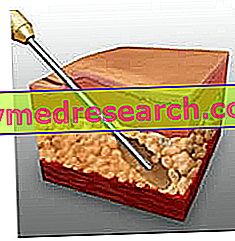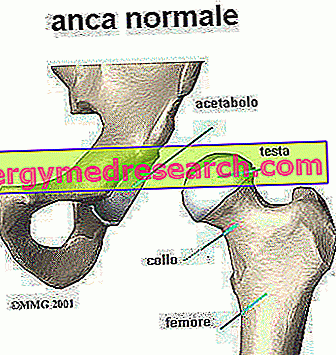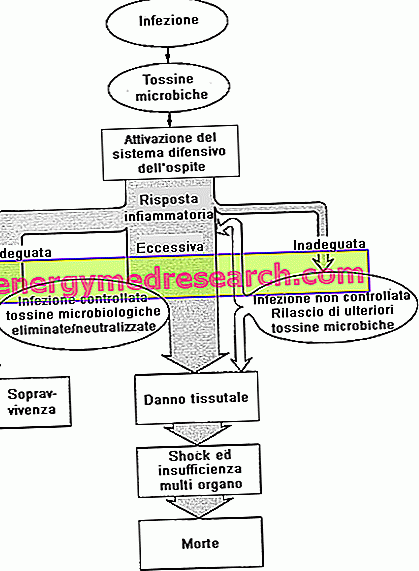What is Liposuction
Liposuction is a surgical technique that removes excess subcutaneous fat deposits, to reshape the contours of the silhouette and improve the aesthetics of the body.
Liposuction is performed on the body areas most subject to the accumulation of fat pads, such as buttocks, abdomen, hips, thighs and knees. The intervention should not be considered a simple and fast method to lose weight, but a real surgical intervention, useful for eliminating localized adiposities resistant to the lipolytic action of diet, exercise and possible cosmetic interventions and aesthetic medicine ( eg mesotherapy).

- Anesthesia : most liposuction procedures are performed under general anesthesia; the administration of a local anesthetic is sufficient only when liposuction is performed on small areas of the body.
- Duration of the procedure : from one to four hours, depending on how much fat is removed, the removal technique and the number of sites subjected to liposuction.
- Post-operative discomfort : variable, mild to moderate, controlled with painkillers.
- Final results : fully appreciated after 4 months (after the post-operative swelling has disappeared) / a year.
- Duration of results : they can be long-lasting if the patient maintains a healthy lifestyle, adopting a balanced diet and exercising regularly.
Liposuction techniques
Dry liposuction
In dry (traditional) liposuction the surgeon makes incisions of a few mm, through which the suction cannula is inserted, then quickly manipulated back and forth. This vibration, exercised manually, allows the surgeon to separate and remove a few kilograms of excess fat and reshape the body contours precisely, particularly on smaller areas, such as the arms, knees or ankles.
Over time, this basic procedure has been progressively refined.
Tumescent liposuction
Developed by plastic surgeons in 1980, it continues to be the mainly used liposuction technique. The tumescent technique is considered safer than other procedures, since it minimizes blood loss. Generally, it is performed under local anesthesia and involves the infiltration of adipose tissue with large volumes of a sterile solution containing anesthetic (up to three times the volume of fat to be removed).
The anesthetic mixture (also called Klein solution) contains:
- Lidocaine, a local anesthetic for pain relief;
- Epinephrine, a drug that causes blood vessels to constrict. This temporary vasoconstriction reduces the possible loss of blood;
- Saline solution, to allow easier removal of fat.
The Klein solution aims to make the adipose tissue tumescent (that is, it makes the fat swell), making the suction with cannula easier and more controlled. Although it tends to take more time than other techniques - from 30 minutes (chin and knee) to 4-5 hours (for most areas involved) - tumescent technique liposuction has the advantage of reducing the risk of bleeding during post-operative surgery and swelling, bruising and pain.
Benefits of tumescent liposuction
Tumescent liposuction has a number of advantages over traditional dry liposuction:
| Tumescent liposuction | Traditional liposuction |
The patient remains alert throughout the procedure (thanks to local anesthesia) and can move as required by the surgeon, facilitating the achievement of certain areas. The effect of the local anesthetic can last up to 24 hours. The soreness or pain after the procedure is generally minimal. | The patient is placed in a state of temporary unconsciousness (temporary general anesthesia), with any related risks. After surgery, when anesthesia wears off, the patient may experience significant pain or discomfort that may require analgesics. |
Blood loss is minimized by vasoconstriction of blood vessels, induced by epinephrine administered in solution with a local anesthetic (Klein solution). | Potential severe blood loss. |
The bruises are minimal and can last from 7 to 14 days. | Ecchymosis is usually significant and can last up to 3-6 weeks. |
Dressings or support clothing are indicated for approximately 1-3 weeks. | Dressings and support clothing are indicated for about 4-6 weeks. |
After the procedure, patients can return to work within 1-2 days. | The convalescence needs approximately one or two weeks. |
This technique inflates the adipose tissue, highlighting the defects on which to act: in this way, the surgeon can precisely remove what is necessary and reduce the risk of post-operative irregularities. | It can produce noticeable dimples in the skin and require a further operation to correct irregularities. |
The main disadvantage of tumescent liposuction is that it takes more time to remove a given volume of fat than the traditional method.
Super wet liposuction
This technique is similar to tumescent liposuction, with the exception that it uses less anesthetic fluid: the surgeon injects a volume of solution equal to the amount of fat to be removed. Although a small amount of lidocaine is sometimes added to the liquid, this technique often requires general or epidural anesthesia. The procedure requires from one to two hours of execution.

Ultrasound assisted liposuction (UAL)
The UAL technique uses a special suction cannula, which vibrates very quickly and emits ultrasound. Sometimes this procedure is used in combination with tumescent liposuction.
During ultrasound-assisted liposuction, the surgeon uses a particular device above or below the skin, which emits ultrasound energy and breaks down the walls of fat cells, forming an emulsion. The liquefied fat is then removed. Ultrasound-assisted liposuction takes longer than other methods, but is more precise and tends to be more effective in removing fat from fibrous areas of the body (such as the male breast). The disadvantage is that it generates a lot of heat and, if the ultrasound cannula is not removed quickly enough, it can cause burns. Laser assisted liposuction (LAL) is based on principles similar to the UAL.
Power-assisted liposuction (PAL)
In power-assisted liposuction (PAL), instead, plastic surgeons have a special cannula available, which uses vibrations to break up fat cells so that they can be sucked. The cannula moves back and forth at a very fast speed over a distance of 3-5 millimeters. PAL can remove more fat in a short period of time (per minute, about 40% more fat than manual liposuction), which means that the procedure takes less time to perform, providing uniform results and a quick recovery postoperative.
Risks and Complications
All surgical procedures involve a certain risk.
Liposuction is generally a safe procedure and any side effects are minimized, especially if extremely long procedures or excessive removal of adipose tissue are avoided. The possibility that a complication arises increases if the surgeon has to intervene on very large surfaces of the body or if multiple procedures are provided during the same operation.
Before undergoing liposuction, it is important to weigh up the risks and benefits, understanding the limits and the possible complications.
Side effects, unlike complications, are temporary and minor unwanted events, although they can be bothersome and painful:
- Pain, swelling and bruising: they should gradually decrease over the course of a month or two, but can last up to six months.
- Scars: they vary in size depending on the procedure adopted, and should become less and less evident over the weeks. For some, the "healing" of a scar can take up to a year.
- Numbness: sometimes persists for a few weeks.
- Post-operative weight gain.
- Limited mobility: it will depend on the exact procedure adopted by the surgeon.
There may be various factors that limit movement for a short period, such as:
- Need to wear an elastic compression garment;
- Swelling or pain in areas subjected to liposuction.
Possible complications that may arise following liposuction are:
- Infections . Whenever the body is incised or perforated, the bacteria can enter and cause an infection.
Skin infections after liposuction are rare but possible. In some cases, these can be serious or life-threatening, such as in cases of necrotizing fasciitis or toxic shock syndrome. The doctor may prescribe an antibiotic to be taken before and after surgery for a prophylactic purpose, ie to prevent any infections. From this point of view, it is also important to keep the incision wounds clean.
- Embolism . the fat droplets separated during liposuction can enter the blood, turning into real "wandering mines" called emboli. Through the blood vessels, fat emboli can reach organs such as the lungs or brain, causing permanent disability or, in some cases, being fatal. Therefore, an adipose embolism represents a real medical emergency. Signs of a pulmonary embolism can include breathing difficulties. Rarely, blood clots can cause deep vein thrombosis in the legs.
- Visceral perforations . During liposuction, the doctor is unable to see the tip of the cannula. Rarely, a probe that penetrates too deeply could pierce or damage an internal organ, such as the intestine during abdominal liposuction. This damage can be corrected surgically, even if, in rare cases, visceral perforations can be fatal.
- Seroma . After liposuction, an accumulation of serum may form at the subcutaneous level in areas where the tissue has been removed.
- Nerve compression and changes in sensation . "Paresthesia" may occur, with a temporary or permanent change in sensitivity (at the liposuction site), which may be increased (pain) or decreased (numbness in the area). If these changes in sensitivity persist for a long period of time (weeks or months), you should tell your doctor.
- Skin necrosis (death of the skin) . In rare cases, the skin above the liposuction site can become necrotic (changes color and falls). During healing, the resulting wound requires extreme care in care, as large areas of skin necrosis can be infected by bacteria or microorganisms.
- Burns . During ultrasound-assisted liposuction, probe heat can cause injury to the skin or deeper tissues.
- Fluid imbalance . Fatty tissue contains a lot of liquid, which is removed during liposuction. In addition, the surgeon can inject large amounts of fluids during the procedure (as in the case of tumescent liposuction). This can lead to a disturbance of the body's electrolyte balance and, consequently, to serious cardiac, pulmonary and renal diseases.
- Anesthesia toxicity . Lidocaine is often used as a local anesthetic during liposuction. If large volumes of anesthetic mixture are injected, or if it contains too high a concentration of lidocaine, a toxicity reaction may occur, manifested by signs such as: dizziness, agitation, drowsiness, tinnitus (ringing in the ears), difficulty of word, metallic taste in the mouth, numbness of the lips and tongue, chills, muscle contractions and convulsions. Lidocaine toxicity can cause cardiac arrest and can be fatal. In general, any type of anesthesia can cause complications and this risk is always considered during surgery.
- Outline irregularities, depressions or dimples of the skin surface. The skin may appear irregular or flaccid due to irregular removal of fat, poor skin elasticity or unusual healing. Sagging skin occurs when the skin of the area subjected to liposuction does not shrink around the newly contoured contours. Patients with cellulite can develop skin irregularities due to an over or under-correction of localized fat deposits. These changes could be permanent.
- Deaths related to liposuction . From the news, from time to time alarming reports of victims related to the liposuction procedure come. It is important to remember that liposuction is a surgical intervention, which as such - although safe compared to other more invasive interventions - can also lead to serious complications, including death.
How much?
One of the most important considerations on whether to undergo liposuction is the cost of the intervention.
Factors that determine liposuction costs include:
- Areas to be subjected to liposuction and quantity of fat to be removed;
- Surgeon's experience;
- Operating theater costs and pre-operative laboratory (laboratory tests, anesthesia, etc.);
- Other related expenses, such as compression garments worn after the procedure, etc.
The average cost for liposuction with the traditional method varies approximately from 1, 000 euros (for example: knees or arm) to 5, 000 euros (for abdomen and hips).




